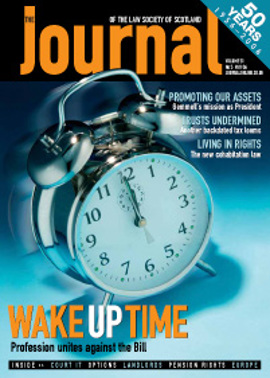Apportioning and sharing

Apportionment of pension rights
Once the values of the pension rights have been obtained, those values need to be apportioned to reflect the period of the marriage.
The basis on which apportionment should take place is laid down in regulation 4 of the Divorce etc (Pensions) (Scotland) Regulations 2000 (SSI 2000/112). However a growing and potentially significant difficulty has arisen, primarily because of poor drafting of those regulations; this can lead to rights that have not been acquired during the marriage (in pensions law at least) being included in the apportionment. A further issue is that schemes will often perform the apportionment, but not always correctly; the question of whose responsibility it is to apportion the pension rights correctly is an important one for the lawyer to consider.
To understand why this is the case, it is worth recalling that, as part of the ECJ judgment in the case of Barber v Guardian Royal Exchange [1990] IRLR 240 the court determined that pensions were deferred pay. The consequence of that determination is that pensions can only accrue, or be acquired, when a member is in employment.
This distinction is recognised in the current pensions statutes by the definition of three categories of pension scheme membership – namely active, deferred and pensioner. Only an active member is defined as being in “pensionable service”, in other words accruing or acquiring pension rights. SSI 2000/112 defines active and deferred membership by reference to section 124 of the Pensions Act 1995; however the regulations do not refer, except indirectly, to the only other possible category of pension scheme membership, namely pensioner membership, which is unfortunate.
Regulation 4 makes reference only to membership, without distinguishing the type of membership that should be considered; nor does it define the term “membership”. Strict interpretation of the regulation, therefore, will lead to the apportionment of pension rights on the basis of all membership rather than active membership – and that will lead to pension rights that are acquired outside the period of marriage being included in the matrimonial assets. This could lead to very unfair, and almost certainly unintended consequences.
Apportionment anomalies
Two simple (but theoretical) examples will illustrate the unfairness. Consider a husband who joins a pension scheme on the day of his marriage and leaves it 10 years later, on the day he separates from his wife: no further rights (in pensions law) will therefore be acquired after the day of separation. Clearly 100% of the value of the rights should be included in the matrimonial assets. Assume he offsets the value against other assets in the separation agreement. This leaves his pension benefits intact but he will have passed over other assets of 50% of their value.
Assume he (theoretically) marries his second wife on the date he separated from his first wife, and then separates from his second wife 30 years later; on the basis of the strict “membership” definition, 75% of the total value of the pension rights he accrued in that scheme will be included in the matrimonial property on his second divorce. Assuming he again agrees to offset, he will have now have passed over further assets with a value of
37 1/2% of the value of his total pension rights. He will therefore have passed over a total value of assets in the two settlements of 87 1/2% of his total pension rights. If the active membership rule is used, the more logical answer of offsetting 50% of the value of his pension rights on first divorce and offsetting nothing on second divorce would be the outcome. On the other hand, if he had divorced his first wife after 40 years, only 50% of the value of his pension rights would have been available to offset.
Another strange outcome of using the “all membership” definition arises if pension sharing rather than offsetting had been agreed on the first divorce. If, on the first divorce, 50% of the value of the pension rights had been transferred by way of a pension share, rather than being offset, then the husband would retain only 50% of those rights as an asset. It is the value of the reduced rights that will appear in the schedule of matrimonial assets on the second divorce – with the effect, clearly, being a worse outcome for the second wife, than if the pension rights had been offset in the first divorce settlement. It is hard to believe that this is the intention of the legislation.
Pensions in payment
If it is accepted that the definition of “all membership” includes pensioner membership, then even more curious results arise if a pension is already in payment. Consider this example. Assume the husband joined the pension scheme in 1982, married in 1991, retired in 1992 and separated in 2002. Using the active membership definition, he was married for one year out of his 10 years of active membership – so 10% of the value of his pension rights should be included in the matrimonial property. Using the all membership definition he would have been married for 11 years out of a total of 20 years of membership, meaning that 55% of the value of his pension rights would be included; had he benefited from ill health retirement terms this would be a most unfortunate outcome. Furthermore, if the marriage had taken place in 1993, it is difficult to believe the law intended that 45% of the value of the pension rights should be included in the matrimonial property.
In our view, it would take a relatively modest change to the relevant regulation to introduce a far higher degree of fairness into the apportionment process. Hopefully that will happen soon, but until then, or until the matter is properly considered in court, family lawyers will continue to wrangle over the proper interpretation of the regulations as currently worded.
Offsetting versus sharing
Many family lawyers will not advise their clients to consider pension sharing because the amounts are small or because sharing is “difficult” and “expensive”. While the former reason is quite understandable, the latter is not, even though sharing can be difficult and relatively expensive. And defaulting to offsetting as a means of settlement, without considering sharing, may mean that the lawyer is effectively giving poor financial advice, perhaps unconsciously. We suspect though that ignorance would not be an acceptable defence if an unhappy client took action.
Of course any consideration of offsetting versus sharing implies that the assets exist to allow this flexibility – and clearly we make this assumption in this section. But where that flexibility does exist, sharing should certainly be actively considered.
While in most cases sharing will benefit one party at the expense of the other, this will not always be the case – particularly where one of the parties is in very poor health. In these circumstances sharing may be of benefit to both parties, with the pension scheme being the loser.
Part of the problem with giving advice about the merits of sharing and offsetting is that like is not being compared with like. All other things being equal, each pound of a non-pension asset is of higher value than a pound of pension assets. One only need to think that the cost of creating £1 of pension asset is £0.78 for the standard rate taxpayer or £0.60 for the higher rate taxpayer to realise that that is the case.
Unfair CETVs
However the other part of the problem is that very often the CETV is not a fair reflection of the pension rights being valued; in other words the cost (after taking into account tax relief) of replacing the pension rights on the open market may be significantly different from the CETV. To put it another way, there are many schemes where an independent financial adviser would be hauled up before the financial regulator if they recommended transfer. Of course, all this goes to illustrate how “cheap and cheerful” the use of the CETV is, as a means of valuing pension rights for matrimonial property purposes; while it is certainly cheap, sometimes it can be too cheerful!
Examples of situations where the CETV may not properly reflect the pension rights being valued would include private final salary schemes where the scheme is significantly underfunded; pensions in payment to a scheme member who is in poor health; and insured pension policies where there are valuable guarantees – like those that brought down Equitable Life.
It is also worth noting that the valuations of public sector pension rights – including SERPS – bear little reality to a commercial basis. The CETV bases for these have been in place for some time, and as a result do not reflect current economic or indeed mortality conditions.
It is most important for family lawyers to realise that the CETV is simply a means of conversion, a means to an end. It should always be the impact on the pension rights that influences decisions that are made regarding sharing.
So the important point for the family lawyer is to ensure that in advising their client to agree to sharing, or to resist it, there is a clear understanding of what pension rights are being given up or obtained as a result of sharing. If they are in doubt then the benefit of professional advice will be well worth recommending to the client.
Pensions in payment
One specific issue relating to pensions that are in payment is worth considering – although we are unaware of any court having considered it. The actuarial valuation of a pension in payment involves discounting all possible future payments, from the relevant date onwards. So the value that is placed on the matrimonial assets of the husband has taken all future payments into account. It would not be uncommon for the husband to make alimentary payments to his wife – particularly if this was the main source of the couple’s income. But, certainly from an actuarial point of view, these alimentary payments are effectively a disbursement or transfer of the matrimonial assets from the husband to the spouse, and should be taken into account in any financial settlement. However, conversations we have had with family lawyers suggest that there are a range of views on this issue!
Finally, it will often be the case that financial agreement is reached some time after the date of separation. However the information obtained about the various matrimonial assets, including pension rights, will have been current at the date of separation. We believe that it is most important that family lawyers base any advice on information current at the date of financial agreement: giving what is effectively financial advice on information that is months and perhaps years out of date is asking for trouble.
John Buchanan is an actuary with Collins Actuaries, Edinburgh and Glasgow. Part 1 appeared in the April Journal at page 30.
In this issue
- Stand up to be counted
- A bill to divide us
- The pendulum swings
- The pendulum swings (1)
- Cohabitation: the new legal landscape
- The tax man cometh (again)
- The foreign legion
- Making IT happen
- Apportioning and sharing
- Property problems
- Still a profession
- Arguing over agreements
- Next generation law
- Lawyers in the transfer market
- Scottish Solicitors' Discipline Tribunal
- Landlords: setting the mark
- Website review
- Book reviews
- Purchase options in leases






